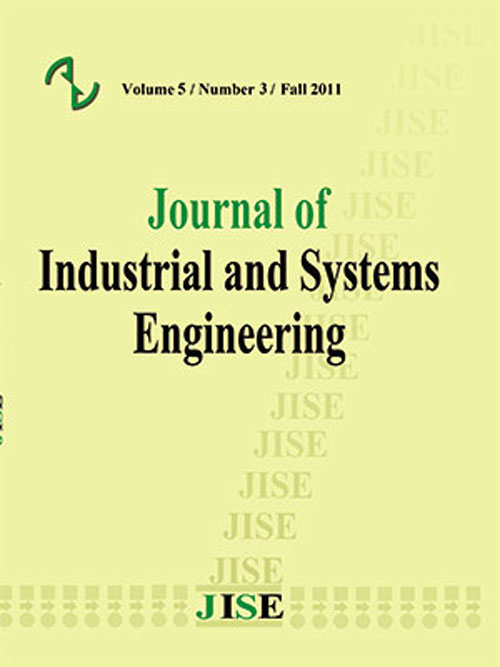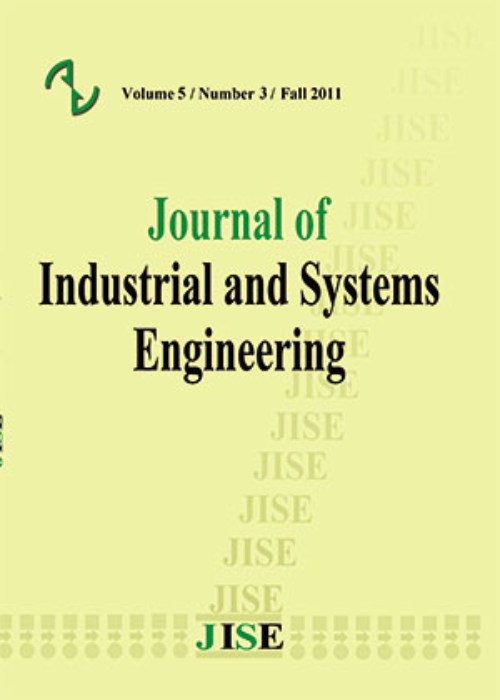فهرست مطالب

Journal of Industrial and Systems Engineering
Volume:5 Issue: 3, Autumn 2011
- تاریخ انتشار: 1392/02/22
- تعداد عناوین: 4
-
-
Page 128In this article a new algorithm is developed for optimizing computationally expensive simulation models. The optimization algorithm is developed for continues unconstrained single output simulation models. The algorithm is developed using two simulation optimization routines. We employed the nested partitioning (NP) routine for concentrating the search efforts in the regions which are most likely contained the global optimum, and we used the experimental design concept for selecting most promising points. Then we integrated the Particle Swarm Optimization (PSO) routine as the searching mechanism of the developed algorithm to single out the best point (optimal or a near optimal solution). Through these integrations, an algorithm was developed which is capable of optimizing digital simulation models. The efficiency of the developed algorithm was then evaluated through a computationalexperiment. Ten test problems were selected from the literature and the efficiency of the PSPO algorithm was compared by two well-known algorithms. The result of this experiment revealed that the developed algorithm provided a more accurate result comparing to these algorithms.Keywords: Simulation optimization, Nested Partition Algorithm, Sequential Experimental Design, Particle Swarm Optimization Algorithm
-
Page 142This paper presents the idea of creating cells while reducing part-level sequence dependent setup time in general cellular manufacturing systems (CMS). Setup time reduction in CMS has gained modest attention in the literature. This could be attributed to the fact that the fundamental problem in cell formation in CMS has been mainly related to material handling and machine utilization while setup time was assumed to implicitly decrease as a result of grouping similar parts in a manufacturing cell. Despite more than three decades of CMS’s history, it has been relatively recent that setup time has been included in cell formation problems and found a place in the existing models. However, sequence-dependent setup time in the literature has been dealt with mostly within the context of scheduling “part-families” in a single manufacturing cell or in the allocation of parts to flow line cells. The present model includes the three fundamental elements of a cell formation procedure: machine utilization, intercellular movement and setup time. This therefore provides a basic structure that would serve as a general sub-model for real manufacturing cell formation problems including any type of setup time and manufacturing cell. Due to computation time and complexity of the problem, a solution approach based on theGenetic Algorithm based (GA-based)heuristic has been discussed and the solution of a sample problem has been compared with that of conventional optimization software. The results indicate a reasonably satisfactory performance by the GAbased heuristic in terms of accuracy and computation time.Keywords: Sequence, dependent, Setup time, Part, level, Cellular manufacturing system(CMS), Genetic Algorithm
-
Page 154The objective of this paper is to study an integrated two-supplier supply chain whose suppliersare unreliable. An unreliable supplier is alternative between available (ON) and unavailable (OFF) states which are considered to be independent exponential variables. The suppliers apply a continuous review policy and the retailer uses an adapted continuous review base on a (R,Q)policy. Transportation times are constant and lead times are non-zero random variables. The retailer faces independent Poisson demands. Using the idea of the one-for-one ordering policy, we implicitly incorporate the distribution function of the random delay for obtaining the value of the expected costs of system. Finally, resorting to a dozen of sample problems, we show that the average cost reduction in our inventory system is at least 3.69% and at most 36.95 comparing to the one with only one supplier.Keywords: Supply Chain Management, Unreliable Supply, Continuous Review Policy, Poisson Demand, Non, Zero Lead, time
-
Page 175Facility location decisions play a prominent role in strategic planning of many firms, companies and governmental organizations. Since in many real-world facility location problems, the data are subject to uncertainty, in this paper, we consider the P-center problem under uncertainty of demands. Using Bertsimas and Sim approach, we develop a robust model of the problem as an integer programming model. Furthermore, we develop a tabu search algorithm for solving the problem. Finally we use design of experiments (DOE) to adjust the parameters of tabu search algorithm. The numerical results of algorithm are presented accordingly.Keywords: Facility location, Robust optimization, P, center, Tabu search


